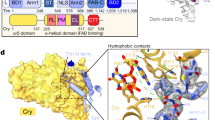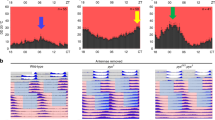Abstract
Light-activated cryptochrome (CRY) regulates circadian photoresponses in Drosophila melanogaster. Removing the carboxy (C) terminus to create CRYΔ produces, in yeast, a light-independent, constitutively active form. Here we show that flies overexpressing CRYΔ have a longer free-running period of locomotor activity, as well as altered cycling kinetics of the clock proteins timeless (TIM) and period (PER). Moreover, at the cellular level, they show a reduction in the level of TIM and in the nuclear localization of TIM and PER in two significant clusters of behavioral pacemaker cells: the large and the small ventral lateral neurons (LNvs). These effects are similar to those seen in wild-type flies under continuous light and suggest a regulatory role for the C terminus of CRY on the photosensitive, photolyase-like part of the protein.
This is a preview of subscription content, access via your institution
Access options
Subscribe to this journal
Receive 12 print issues and online access
$209.00 per year
only $17.42 per issue
Buy this article
- Purchase on Springer Link
- Instant access to full article PDF
Prices may be subject to local taxes which are calculated during checkout





Similar content being viewed by others
References
Allada, R. Circadian clocks: a tale of two feedback loops. Cell. 112, 284–286 (2003).
Peng, Y., Stoleru, D., Levine, J.D., Hall, J.C. & Rosbash, M. Drosophila free-running rhythms require intercellular communication. PLoS Biol. 1, E13 (2003).
Helfrich-Forster, C., Winter, C., Hofbauer, A., Hall, J.C. & Stanewsky, R. The circadian clock of fruit flies is blind after elimination of all known photoreceptors. Neuron 30, 249–261 (2001).
Helfrich-Forster, C. The neuroarchitecture of the circadian clock in the brain of Drosophila melanogaster. Microsc. Res. Tech. 62, 94–102 (2003).
Cashmore, A.R., Jarillo, J.A., Wu, Y.J. & Liu, D. Cryptochromes: blue light receptors for plants and animals. Science 284, 760–765 (1999).
Emery, P., So, W.V., Kaneko, M., Hall, J.C. & Rosbash, M. CRY, a Drosophila clock and light-regulated cryptochrome, is a major contributor to circadian rhythm resetting and photosensitivity. Cell 95, 669–679 (1998).
Ceriani, M.F. et al. Light-dependent sequestration of TIMELESS by CRYPTOCHROME. Science 285, 553–556 (1999).
Rosato, E. et al. Light-dependent interaction between Drosophila CRY and the clock protein PER mediated by the carboxy terminus of CRY. Curr. Biol. 11, 909–917 (2001).
Brand, A.H. & Perrimon, N. Targeted gene expression as a means of altering cell fates and generating dominant phenotypes. Development 118, 401–415 (1993).
Konopka, R.J., Pittendrigh, C. & Orr, D. Reciprocal behaviour associated with altered homeostasis and photosensitivity of Drosophila clock mutants. J. Neurogenet. 6, 1–10 (1989).
Marrus, S.B., Zeng, H. & Rosbash, M. Effect of constant light and circadian entrainment of perS flies: evidence for light-mediated delay of the negative feedback loop in Drosophila. EMBO J. 15, 6877–6786 (1996).
Renn, S.C., Park, J.H., Rosbash, M., Hall, J.C. & Taghert, P.H. A pdf neuropeptide gene mutation and ablation of PDF neurons each cause severe abnormalities of behavioral circadian rhythms in Drosophila. Cell 99, 791–802 (1999).
Blanchardon, E. et al. Defining the role of Drosophila lateral neurons in the control of circadian rhythms in motor activity and eclosion by targeted genetic ablation and PERIOD protein overexpression. Eur. J. Neurosci. 13, 871–878 (2001).
Martinek, S., Inonog, S., Manoukian, A.S. & Young, M.W. A role for the segment polarity gene shaggy/GSK-3 in the Drosophila circadian clock. Cell 105, 769–779 (2001).
Zeng, H., Qian, Z., Myers, M.P. & Rosbash, M. A light-entrainment mechanism for the Drosophila circadian clock. Nature 380, 129–135 (1996).
Rothenfluh, A., Young, M.W. & Saez, L. A TIMELESS-independent function for PERIOD proteins in the Drosophila clock. Neuron 26, 505–514 (2000).
Lin, F.J., Song, W., Meyer-Bernstein, E., Naidoo, N. & Sehgal, A. Photic signaling by cryptochrome in the Drosophila circadian system. Mol. Cell. Biol. 21, 7287–7294 (2001).
Hunter-Ensor, M., Ousley, A. & Sehgal, A. Regulation of the Drosophila protein timeless suggests a mechanism for resetting the circadian clock by light. Cell 84, 677–685 (1996).
Stanewsky, R. et al. The cryb mutation identifies cryptochrome as a circadian photoreceptor in Drosophila. Cell 95, 681–692 (1998).
Emery, P. et al. Drosophila CRY is a deep brain circadian photoreceptor. Neuron 26, 493–504 (2000).
Young, M.W. The molecular control of circadian behavioral rhythms and their entrainment in Drosophila. Annu. Rev. Biochem. 67, 135–152 (1998).
Emery, P., Stanewsky, R., Hall, J.C. & Rosbash, M. A unique circadian-rhythm photoreceptor. Nature 404, 456–457 (2000).
Park, J.H. et al. Differential regulation of circadian pacemaker output by separate clock genes in Drosophila. Proc. Natl. Acad. Sci. USA 97, 3608–3613 (2000).
Dircksen, H. et al. The ultrastructure of nerve endings containing pigment-dispersing hormone (PDH) in crustacean sinus gland: identification by an antiserum against synthetic PDH. Cell Tissue Res. 250, 377–387 (1987).
Yang, H.Q. et al. The C termini of Arabidopsis cryptochromes mediate a constitutive light response. Cell 103, 815–827 (2000).
Rieger, D., Stanewsky, R. & Helfrich-Forster, C. Cryptochrome, compound eyes, Hofbauer-Buchner eyelets, and ocelli play different roles in the entrainment and masking pathway of the locomotor activity rhythm in the fruit fly Drosophila melanogaster. J. Biol. Rhythms 18, 377–391 (2003).
Helfrich-Forster, C. et al. The extraretinal eyelet of Drosophila: development, ultrastructure, and putative circadian function. J. Neurosci. 22, 9255–9266 (2002).
Shafer, O.T., Rosbash, M. & Truman, J.W. Sequential nuclear accumulation of the clock proteins period and timeless in the pacemaker neurons of Drosophila melanogaster. J. Neurosci. 22, 5946–5954 (2002).
Yang, Z. & Sehgal, A. Role of molecular oscillations in generating behavioral rhythms in Drosophila. Neuron 29, 453–467 (2001).
Akten, B. et al. A role for CK2 in the Drosophila circadian oscillator. Nat. Neurosci. 6, 251–257 (2003).
Spradling, A.C. & Rubin, G.M. Transposition of cloned P elements into Drosophila germ line chromosomes. Science 218, 341–347 (1982).
Bae, K., Lee, C., Sidote, D., Chuang, K.Y. & Edery, I. Circadian regulation of a Drosophila homolog of the mammalian Clock gene: PER and TIM function as positive regulators. Mol. Cell. Biol. 18, 6142–6151 (1998).
Myers, M.P., Wager-Smith, K., Rothenfluh-Hilfiker, A. & Young, M.W. Light-induced degradation of TIMELESS and entrainment of the Drosophila circadian clock. Science, 271, 1736–1740 (1996).
Stanewsky, R. et al. Temporal and spatial expression patterns of transgenes containing increasing amounts of the Drosophila clock gene period and a lacZ reporter: mapping elements of the PER protein involved in circadian cycling. J. Neurosci. 17, 676–696 (1997).
Acknowledgements
We thank P. Emery, M. Rosbash and J.C. Hall for tim-GAL4 and UAS-cry flies, P. Taghert and F. Rouyer for pdf-GAL4 and gal1118 strains, respectively; R. Stanewsky and J.C. Hall for anti-PER antibody, M.W. Young & L. Saez for anti-TIM(307) antibody, A. Sehgal for anti-TIM(UPR41) antibody, S. Webster and H. Dircksen for anti-cPDH antibody, and M. Rosbash for anti-PDF antibody. This work was supported by a postgraduate studentship from the Biotechnology and Biological Sciences Research Council (BBSRC) to V.C., a Royal Society Wolfson Research Merit Award to C.P.K., a BBSRC David Phillips Fellowship to E.R. and a BBSRC grant to E.R. and C.P.K.
Author information
Authors and Affiliations
Corresponding author
Ethics declarations
Competing interests
The authors declare no competing financial interests.
Supplementary information
Supplementary Fig. 1
Replotted data from Fig. 5b and Supplementary Fig. 2 online. These graphs show that the relationship between large and small LNvs is completely reversed in control (left panels) and CRYΔ (right panels) flies, this is true for both anti-TIM and anti-PER staining and also N+C and N/C, unlikely to be just a coincidence. The most prominent effect is seen for total TIM levels (N+C). However, the quantification of nuclear staining is likely biased by out-of-focus emission from (more strongly labelled) nearby cytoplasmic regions (see also ref 28), which increases the real N/C ratio. As this artefact is proportionally more important for lower focal emission (real staining), it follows that the quantification of nuclear signal from the large LNvs is likely the most overestimated. (GIF 87 kb)
Supplementary Fig. 2
CRYΔ affects the subcellular localisation of PER in the LNvs. (a) Localization of PER (green) within the small and large LNvs of control (tim-GAL4/+) and CRYΔ (tim-GAL4/UAS-cryΔ) adult brains at the indicated ZTs. PDF (red) was used as marker of neuronal identity and cytoplasmic localisation. (b) Quantification of the nuclear cytoplasmic ratio (N/C) of PER in the two clusters of LNvs for the two genotypes at the indicated ZTs. Quantification data are presented as mean ± s.e.m. At least three brains have been analysed for each genotype at every time point, all visible cells were imaged but only those where PDF staining showed a clear distinction between nucleus and cytoplasm were quantified. Line UAS-cryΔ14.6 was used for these experiments. Due to the high background produced by the anti-PER antibody it was not possible to image a relevant number of cells using the same detector settings, therefore it was not possible to quantify the total level of protein in this experiment. (JPG 47 kb)
Supplementary Fig. 3
Model of CRY function. (a) Under darkness a regulatory molecule (black circle) binds the C terminus, limiting CRY's ability to engage in protein-protein interactions either directly or by action of post-translational modifications. (b) Light promotes a conformational change resulting in the release of the repression (either by release of the regulatory protein or by reversal of the regulatory modification) and in binding with signalling partners (squares), also mediating the degradation of CRY. (c) The removal of the C-terminus prevents the binding of the regulator, allowing signalling to take place under darkness and consequent constant activation/degradation of CRYΔ. (d) Light changes the conformation of CRYΔ, promoting stronger interactions. (GIF 300 kb)
Rights and permissions
About this article
Cite this article
Dissel, S., Codd, V., Fedic, R. et al. A constitutively active cryptochrome in Drosophila melanogaster. Nat Neurosci 7, 834–840 (2004). https://doi.org/10.1038/nn1285
Received:
Accepted:
Published:
Issue Date:
DOI: https://doi.org/10.1038/nn1285
This article is cited by
-
Essential elements of radical pair magnetosensitivity in Drosophila
Nature (2023)
-
Direct experimental observation of blue-light-induced conformational change and intermolecular interactions of cryptochrome
Communications Biology (2022)
-
Tuning flavin environment to detect and control light-induced conformational switching in Drosophila cryptochrome
Communications Biology (2021)
-
Intrinsic disorder is an essential characteristic of components in the conserved circadian circuit
Cell Communication and Signaling (2020)
-
The tail of cryptochromes: an intrinsically disordered cog within the mammalian circadian clock
Cell Communication and Signaling (2020)



